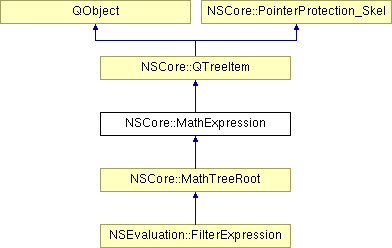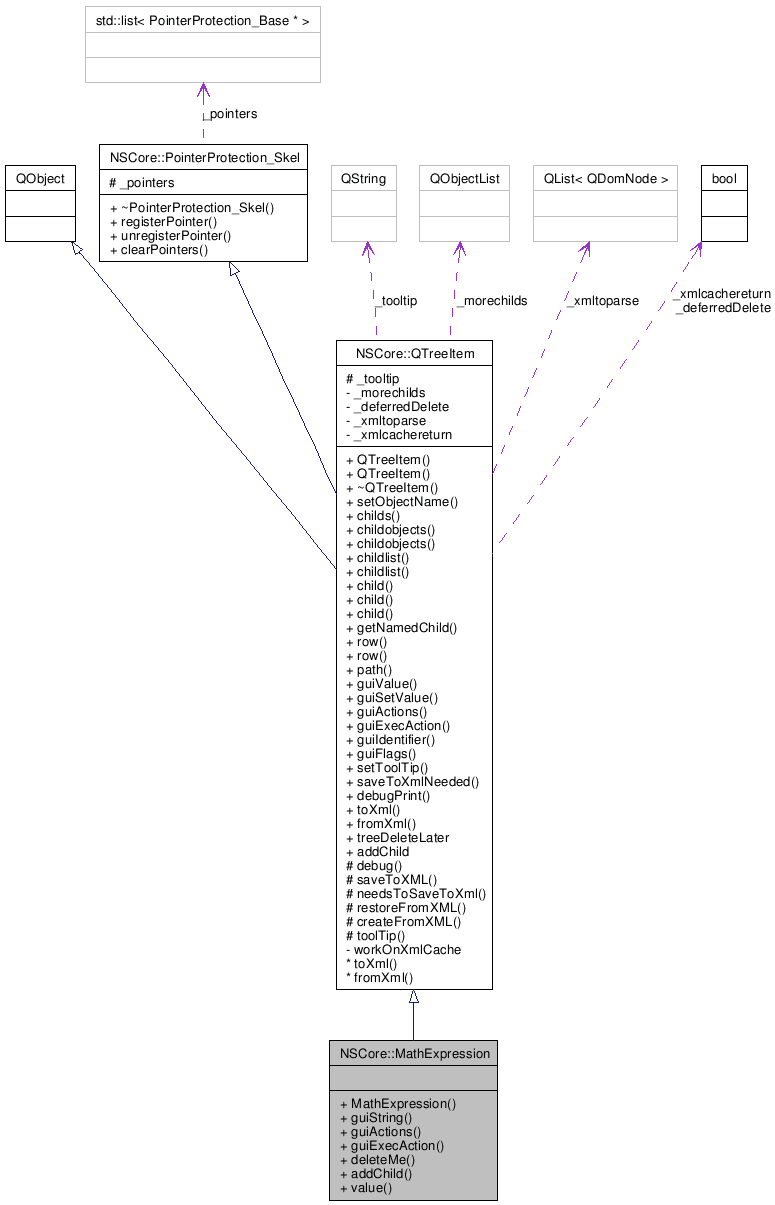NSCore::MathExpression Class Reference
Baseclass for an expression. More...
#include <mathexpression.h>


Public Member Functions | |
| MathExpression (NSCore::QTreeItem *parent) | |
| simple tree-constructor | |
| QString | guiString () const |
| QStringList | guiActions () const |
| GUI: return the supported actions. | |
| void | guiExecAction (QString name, NSCore::GuiServer_Interface *gui) |
| GUI: execute the named action. | |
| virtual void | deleteMe (MathExpression *exp, NSCore::GuiServer_Interface *gui) |
| delete items in a thread-save way... | |
| virtual void | addChild (MathExpression *pexp, NSCore::GuiServer_Interface *gui) |
| add new items in a thread-save way... | |
| virtual double | value (NSCore::AcqisitionDataSet &)=0 |
| Abstract function that does the work. | |
Detailed Description
Baseclass for an expression.Expressions are used to extract any kind of results from the NSCore::AcqisitionDataSet respectively from the results saved in them.
Constructor & Destructor Documentation
| NSCore::MathExpression::MathExpression | ( | NSCore::QTreeItem * | parent | ) |
simple tree-constructor
Member Function Documentation
| QString NSCore::MathExpression::guiString | ( | ) | const |
| QStringList NSCore::MathExpression::guiActions | ( | ) | const [virtual] |
GUI: return the supported actions.
These actions will get symbols/buttons to get executed.
If you implement this, remember to call the parent guiActions() too:
SomeTreeItem::guiActions() const { return QStringList() << <your actions> << BaseClass::guiActions(); }
Reimplemented from NSCore::QTreeItem.
Reimplemented in NSCore::MathTreeRoot.
| void NSCore::MathExpression::guiExecAction | ( | QString | n, | |
| NSCore::GuiServer_Interface * | gui | |||
| ) | [virtual] |
GUI: execute the named action.
If you implemented guiActions() you will also want to implement this. If you can't handle the named action yourself, call guiExecAction() of the parent class.
Of course this can also be used as a filter if you want to restrict access to actions of the parent class.
The second parameter lets you interact with the user by some basic means.
- Parameters:
-
n The action to execute gui The gui to use for interactions
Reimplemented from NSCore::QTreeItem.
Reimplemented in NSCore::MathTreeRoot.
| virtual void NSCore::MathExpression::deleteMe | ( | MathExpression * | exp, | |
| NSCore::GuiServer_Interface * | gui | |||
| ) | [virtual] |
delete items in a thread-save way...
...by handing the action to the parent until it gets handled in a different way.
Reimplemented in NSCore::MathTreeRoot.
| virtual void NSCore::MathExpression::addChild | ( | MathExpression * | pexp, | |
| NSCore::GuiServer_Interface * | gui | |||
| ) | [virtual] |
add new items in a thread-save way...
...by handing the action to the parent until it gets handled in a different way.
Reimplemented in NSCore::MathTreeRoot.
| virtual double NSCore::MathExpression::value | ( | NSCore::AcqisitionDataSet & | ) | [pure virtual] |
Abstract function that does the work.
This has to be implemented to do the work.
Implemented in NSCore::MathTreeRoot, and NSEvaluation::FilterExpression.
The documentation for this class was generated from the following file:
 1.5.5
1.5.5